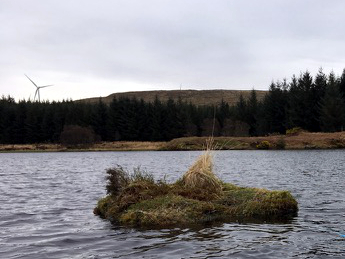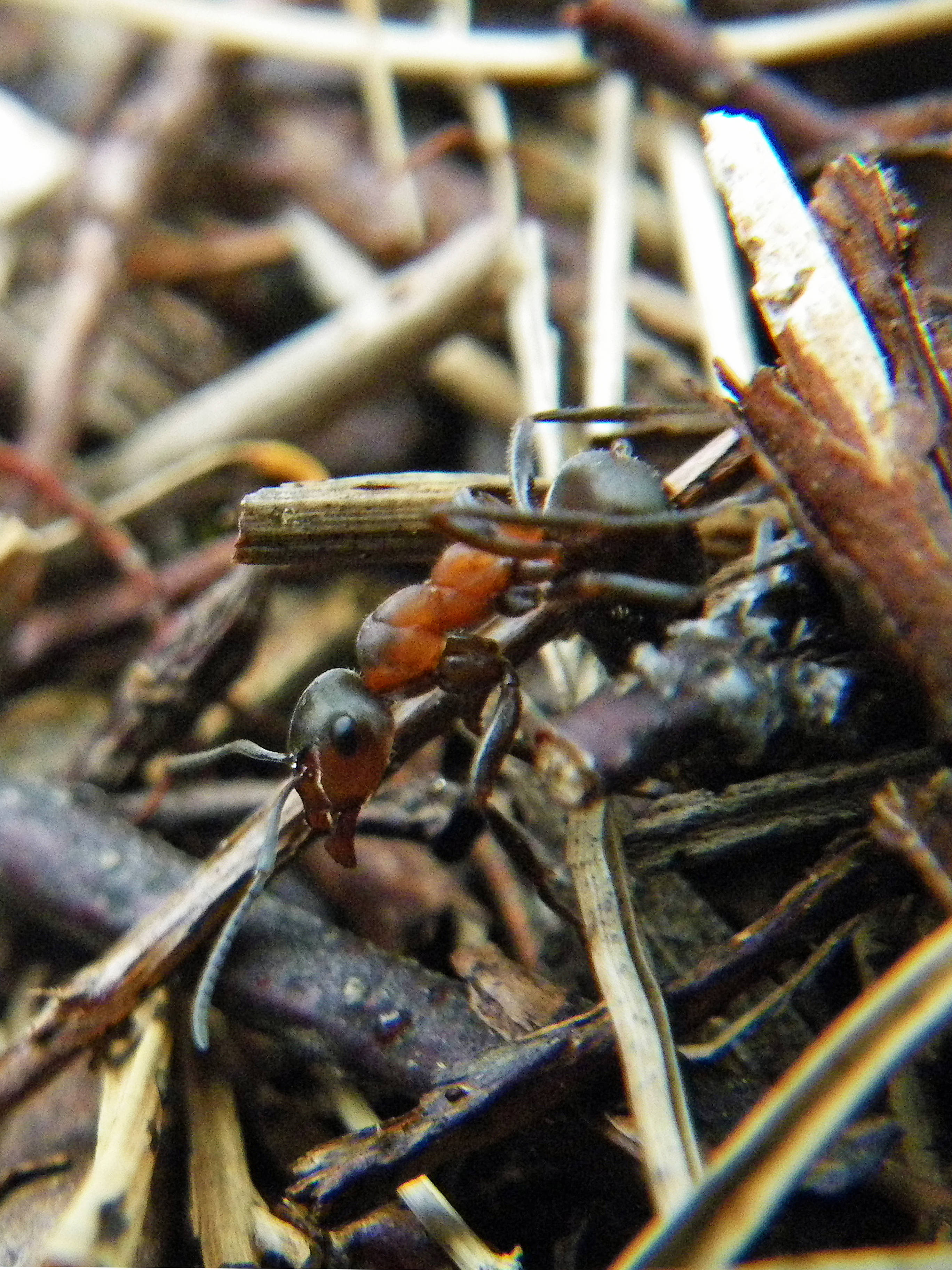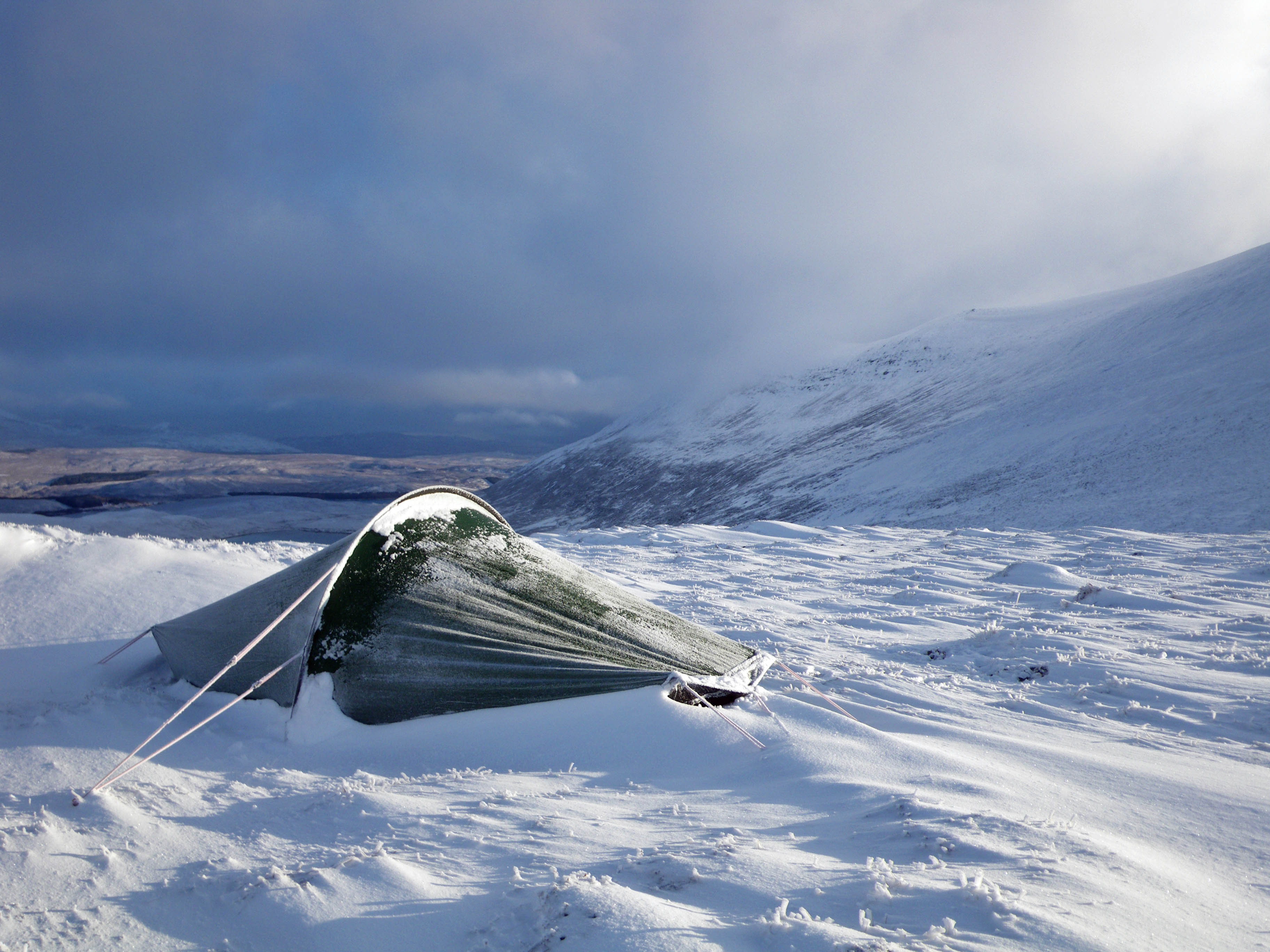16 November 2017 by Chris Cathrine | Comments: 0
Share this article:

Caledonian Conservation has been working to satisfy ecology planning conditions for RES at Freasdail Wind Farm in Kintyre since 2014, involving developing and delivering mitigation for a range of birds, mammals, reptiles and habitats, as well as providing Ecological Clerk of Works (ECoW) services. The final step in this process was the deployment of nest rafts to encourage red-throated divers – rare birds protected under Schedule 1 of the Wildlife and Countryside Act 1981 (as amended in Scotland) – to breed.
Red-throated divers spend winter at sea, and return to breeding territories (usually small lochans in open moorland) in spring. The nest consists of a small scrape, normally located at the water’s edge, or on an island. As nests are often located within easy access of predators such as foxes, otters and gulls, disturbance and predation can cause breeding failure. Nests are also vulnerable to flooding during incubation – an increasingly common problem as summers become wetter as a result of climate change.
Artificial nest rafts have been found to greatly improve the success of breeding divers. These rafts are not susceptible to flooding, as they adjust automatically with the water level, and also limit access to land-based predators.
To avoid disturbance, nest rafts were installed after the major elements of construction were complete. Locations for rafts were carefully chosen to avoid risk of collision with wind turbines while red-throated divers commute between nesting lochans and feeding habitat (the sea and larger waterbodies), and to ensure there would be no human-caused disturbance during operational maintenance activities.
Working with Simon Lawrence (Lawrence Environmental Consultants), the nest rafts were successfully installed by Caledonian Conservation in April 2017, and will hopefully improve the breeding success of red-throated divers in the area in future years.
Read more about RES at: http://www.res-group.com/en
Read more about Freasdail Wind Farm at: http://www.freasdail-windfarm.co.uk/
Photo: Diver nest raft installed near Freasdail Wind Farm © Simon Lawrence
20 March 2017 by Chris Cathrine | Comments: 0
Share this article:

Hexicon AB’s Dounreay Trì floating offshore wind farm has been granted consent by Scottish Government. This groundbreaking demonstration project will help change the face of offshore wind energy generation by allowing turbines to be installed in waters too deep for conventional technologies. Not only does this open up new areas for wind development, but may also reduce potential impacts on marine wildlife (e.g. on seabirds) that may be associated with these projects.
Offshore renewable energy plants need to be connected to the grid, which means there are onshore elements to the Dounreay Trì project. Caledonian Conservation Ltd is proud to have completed the full suite of onshore ecology and ornithology work, as well as the terrestrial Ecological Impact Assessment (EcIA) chapters for the Environmental Statement (ES). Ecological features identified and considered in the assessment included various international and national protected sites designated for a range of features including breeding seabirds, raptors, wintering geese and swans, otter, Scottish primrose sand dune habitats. Other ecological features considered included other protected mammals (badger, pine marten, bats), reptiles, barn owl and other bird species. Being objective and clear, we are pleased that our assessment and recommended mitigation was accepted by the determining authorities without objection.
Read the Scottish Government announcement here.
Read more about the recent council approval on the BBC website.
The full Environmental Statement (ES) and Technical Appendices can be read here, or via our publications page.
Read more about RSPB’s support for the Dounreay Trì in The Scotsman.
Read more about Hexicon AB here.
Read more about RES here.
06 March 2017 by Chris Cathrine | Comments: 0
Share this article:

Caledonian Conservation Ltd staff have a wide range of expertise, and run training courses to share skills and knowledge with other ecology professionals. Training that Chris Cathrine (Director) delivers includes running courses on behalf of the Chartered Institute of Ecology and Environmental Management (CIEEM), the leading professional body for ecologists and environmental managers in the UK and Ireland. Having run great crested newt survey and mitigation courses for CIEEM since 2015, Chris is also delivering Ecological Impact Assessment (EcIA) and wind farm bird collision risk modelling training courses for the professional body in 2017.
CIEEM runs EcIA courses for ecology professionals throughout the UK, ensuring trainers have appropriate experience of the country training is delivered in as relevant legislation and policies are devolved. While updating the EcIA Level 2 course for Scotland, Chris worked with CIEEM’s England and Wales trainer, Mike Dean, and attended one of his courses in Wales to ensure that training would be appropriate but consistent between the UK countries.
Chris delivered his first CIEEM EcIA training course in Scotland last week, at a venue in Edinburgh, drawing on over 10 years' experience as an ecological consultant and his previous roles with Local Authority and as planning casework officer for a conservation charity. Participants came from a range of backgrounds including consultants, charities / NGOs and government agencies / local authorities, really adding depth to group activities and encouraging interesting questions. After all, EcIA principles can be applied to reports supporting planning applications, ecology chapters in Environmental Statements for Environmental Impact Assessment (EIA), Strategic Environmental Assessments (SEAs), Habitats Regulations Appraisals (HRAs), conservation management plans for sites – any project that could impact ecology. The course was a success, based on informal and formal feedback, and Chris is looking forward to running more EcIA training on behalf of CIEEM in the future.
Chris will be running the following courses on behalf of CIEEM this spring:
To find out more about Chris’s other courses delivered as part of CIEEM’s training programme and to book on to these or other events, visit: cieem.activclient.com/CIEEM/Events/Event-Listing.aspx
To find out more about CIEEM, visit: www.cieem.net
23 February 2017 by Chris Cathrine | Comments: 0
Share this article:

Hexicon AB’s Dounreay Trì floating offshore wind farm has been approved by Highland Council and has gained support from RSPB. This groundbreaking demonstration project would be built in Caithness, and could change the face of offshore wind, but still requires approval from Marine Scotland and Scottish Government before it gains consent. Floating wind turbines will allow wind farms to be built further offshore, in deeper waters, limiting their impact on sensitive marine wildlife such as seabirds.
Caledonian Conservation Ltd is proud to have provided the complete suite of onshore ecology and ornithology services for the Dounreay Trì project on behalf of RES Offshore and Hexicon AB – offshore wind farms still need to connect to the grid on land, and Caithness hosts much sensitive wildlife. Our surveys and Ecological Impact Assessment (EcIA) helped ensure the project avoids significant wildlife impacts onshore through careful design and mitigation.
Read more about the recent council approval on the BBC website.
Read more about RSPB’s support for the Dounreay Trì in The Scotsman.
Read the Dounreay Trì planning application, including the onshore ecology and ornithology Environmental Statement chapters, here.
Read more about Hexicon AB here.
Read more about RES here.
12 December 2016 by Chris Cathrine | Comments: 0
Share this article:

At Caledonian Conservation we aim to benefit people and wildlife. To achieve this, we feel it is essential to share our experiences with other professional and academic ecologists to help improve best practice (within legal and commercial restrictions). This includes presenting articles in the Chartered Institute of Ecology and Environmental Management (CIEEM) In Practice publication, which is distributed to the organisation’s membership. Director Chris Cathrine has been an author of four articles in this publication, and we are pleased that we are now able to offer these publicly on the Caledonian Conservation Ltd website. These articles include:
Cathrine, C. 2015. Wood Ant Nest Translocations. In Practice 89, 14-18.
Cathrine, C. and Amphlett, A. 2011. Deadwood: Importance and Management. In Practice 73, 11-15.
To explore other publications, research posters and conference papers, go to the Caledonian Conservation publications page.
To learn more about the Chartered Institute of Ecology and Environmental Management, visit their website.
23 November 2016 by Chris Cathrine | Comments: 0
Share this article:

Caledonian Conservation Ltd presented a case study of reptile mitigation work we have been undertaking in Scotland at a conference on 9th October 2016 in Cheddar focussing on adder conservation in the UK - The Vanishing Viper: Priorities for adder conservation (organised by Amphibian & Reptile Groups of the UK and Amphibian & Reptile Conservation Trust).
The case study involves an underground cable route which will connect RES Ltd Freasdail Wind Farm to the grid. This route crosses over 10 km of reptile habitat where adders, common lizards and slow-worms are present. However, the construction methods are relatively low impact and transient. As the erection of a reptile fence of such length would have a greater negative effect than the construction itself, an innovative approach was developed to avoid harm to reptiles during works. This contrasts with the construction of the wind farm itself, where traditional reptile mitigation using fencing was appropriate.
The presentation was given while works were still in progress, however construction of the cable has since finished and no evidence of harm to reptiles has been recorded. Therefore, in this case, we conclude that the approach developed was appropriate for Freasdail Wind Farm. However, at present there is no formal published guidance on reptile mitigation in the UK and this is urgently needed to help protect these special animals.
We hope to publish a detailed article on the mitigation approach and results in the future, so that other ecologists may learn from this work in the absence of formal guidance.
As Director Chris Cathrine was expecting the imminent arrival of his second child, Ian Bradley (Ecological Clerk of Works for much of the project) kindly delivered the presentation, which is available to download here.
For more information about RES Ltd, go to: http://www.res-group.com/en
For more information about Amphibian & Reptile Groups of the UK, go to: http://www.arguk.org
For more information about Amphibian & Reptile Conservation Trust, go to: http://www.arc-trust.org
11 November 2016 by Chris Cathrine | Comments: 0
Share this article:

We are very pleased that Creag Riabhach Wind Farm (Sutherland) gained consent on 17th October 2016. Between 2012 and 2014, Caledonian Conservation Ltd provided the full ecology and ornithology services for Creag Riabhach Wind Farm, from feasibility to Ecological Impact Assessment (EcIA).
Creag Riabhach Wind Farm will provide a boost to the local rural economy, improve local biodiversity, and help combat climate change by generating clean energy and through peatland restoration.
If you would like to read more about the ecology and ornithology work, the relevant chapters from the Environmental Statement are available to download from our publications page.